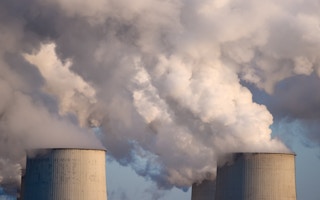Global warming could have even more devastating consequences than anybody so far has predicted. New calculations suggest that if humans go on burning all known fossil fuel reserves at the present rate, global average temperatures could rise by 8°C by 2300, and the Arctic could become 17°C warmer.
Since the worst predictions for the immediate future put global average warming at 4°C by the end of the century, and 195 nations have pledged to try to constrain temperature rise to an average of less than 2°C, the new set of projections by Canadian scientists is a reminder that global action is urgent.
Katarzyna Tokarska, a climatologist at the University of Victoria, and colleagues report in Nature Climate Change that they looked once again at the long-term relationship between greenhouse gas levels in the atmosphere and global average temperatures.
Previous studies have confirmed that the link holds – in scientific language, the connection is linear – all the way up to the combustion equivalent of two trillion tonnes of carbon dioxide emissions.
Highly complex
But the interplay of rock, ocean and atmosphere is highly complex, and there have been suspicions that, beyond that, the response might not be so simple.
Clouds, for example, might by then build up to levels that would reflect sunlight and actually damp down the temperature increases. And plant life in the oceans could become more productive, and gulp down and sequester carbon at a greater rate. So what seems true now might not remain so in extreme circumstances.
But the Canadian scientists tested the long-term warming pattern by running computer simulations that modelled a world in which the most conservative estimates for fossil fuel resources were all consumed. This would put five trillion tonnes of carbon dioxide equivalent into the atmosphere.
They found that the relationship held. Their models predicted, at the very least, a long-term global warming of 6.4°C, and possibly as high as 9.5°C.
However, the average warming in the Arctic – and this is important, because it is the difference between tropics and polar temperatures that maintains the world’s weather systems and dictates the patterns of climate – would be at least 14.7°C and possibly up to 19.5°C.
“These results indicate that the unregulated exploitation of the fossil fuel resource could ultimately result in considerably more profound climate changes than previously anticipated,” the scientists conclude.
A little of the story so far: from the mid-18th century, with the invention of the first coal-burning steam engines, humans began steadily to increase carbon dioxide levels in the atmosphere. These are still at the tiny proportion of 400 parts per million, but global average temperatures have increased by 1°C in the last century.
“
These results indicate that the unregulated exploitation of the fossil fuel resource could ultimately result in considerably more profound climate changes than previously anticipated.
Scientists from University of Victoria
Governments agreed almost a decade ago that a rise of more than 2°C would have catastrophic consequences in terms of sea level rise, climate change and extremes of heat, storm and drought.
World leaders agreed at the UN climate change conference in Paris last December to aim to limit the global average rise to 1.5°C, and announced – but have yet to implement – national plans to shift to renewable resources.
The Canadian study is not the first to suggest that the threat posed by global warming is potentially more devastating than anything agreed by the UN’s Intergovernmental Panel on Climate Change, which offers a consensus based on a range of predictions. And other researchers have pushed the what-could-happen logic to entirely theoretical levels of planetary devastation, in which the oceans ultimately boil away and all life is obliterated.
But the Canadian study is different: it takes the immediate and enduring possibilities, then follows them to the foreseeable end.
Twice as arid
And this end – while not likely to extinguish life on Earth – is not a pretty one. A warmer atmosphere has a greater capacity for saturation with moisture, so the study calculates that in the already rainy tropical Pacific, regional precipitation will increase by a factor of four. But parts of Australia, the Mediterranean, southern Africa – regions that are already relatively dry – will become twice as arid.
Ominously, rainfall over the Amazon, the world’s last great rainforest, will be halved. And Central America and North Africa will become almost three times as dry. Landscapes at present home to billions of people could become increasingly uninhabitable, as temperatures rise and harvests become more vulnerable.
“Our results also show that five trillion tonnes of cumulative carbon emissions, corresponding approximately to the unregulated exploitation of the fossil fuel resource, would result in considerably larger global and regional changes than previously suggested,” the scientists write.
“Such climate changes, if realised, would have extremely profound impacts on ecosystems, human health, agriculture, economies and other sectors.”










